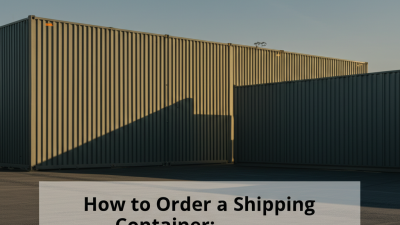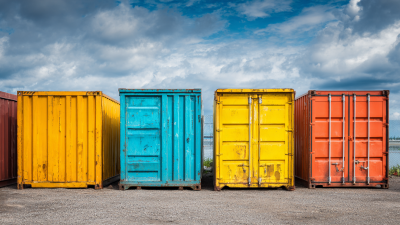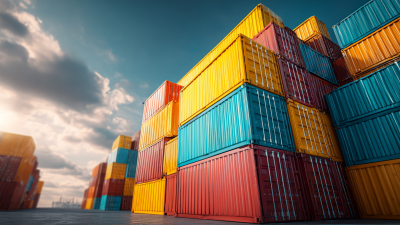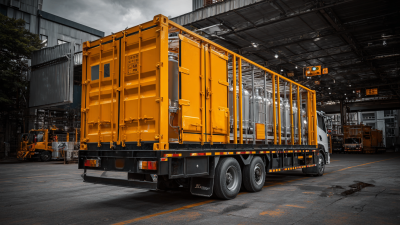How to Order a Shipping Container: A Step-by-Step Guide for Beginners
Ordering a shipping container can seem daunting, especially for beginners venturing into the world of shipping and logistics. However, understanding the process of how to order a shipping container is essential for anyone looking to transport goods efficiently or start a shipping business.

This comprehensive guide will walk you through the intricate steps involved in ordering a shipping container, from determining the right type and size for your needs to selecting a reliable supplier and arranging delivery. Whether you're looking to buy a new or used container, each step is crucial in ensuring that your order is processed smoothly and meets your specific requirements.
By following this guide, you will gain confidence in navigating the complexities of the shipping container industry, enabling you to make informed decisions and streamline your logistics operations effectively.
How to Determine the Right Type of Shipping Container for Your Needs
When determining the right type of shipping container for your needs, the first step is to assess what you plan to store or transport. Shipping containers come in various sizes and configurations, including standard dry containers, refrigerated containers for perishables, and specialized units for oversized or hazardous items. For example, a standard 20-foot container might suffice for general cargo, while a 40-foot high cube container can accommodate larger shipments or bulkier items. Understanding your inventory requirements will guide you in making the right size selection.
Next, consider the climate and the specific conditions your cargo may face during transport. If you are shipping sensitive items like food or pharmaceuticals, a refrigerated container would be ideal to maintain temperature control. Conversely, if your cargo is robust and not affected by external conditions, a dry container may be more cost-effective. Additionally, evaluate whether you need features like enhanced security or insulation based on your goods. By carefully analyzing these factors, you can choose the most suitable container that fits your logistical needs, ensuring safe and efficient transport of your cargo.
Key Factors to Consider When Choosing a Shipping Container Supplier
When choosing a shipping container supplier, several key factors come into play that can significantly affect both your experience and the quality of the container you receive. First, consider the supplier's reputation. Look for reviews and testimonials from previous clients to gauge their reliability and customer service. A supplier with a strong track record is more likely to provide you with a quality product and responsive support.
**Tips:** When researching suppliers, use platforms like Google Reviews or Trustpilot to get an unbiased view of their services. Additionally, consider reaching out to other businesses that have purchased containers from them to gain insights into their experiences.
Another important factor is the type of containers they offer. Depending on your needs, you may require specific sizes or modifications. Ensure the supplier has a variety of options, including new and used containers, and can accommodate any custom alterations you might need.
**Tips:** Always ask for detailed specifications of the containers available, including dimensions, condition, and any available modifications. Don’t hesitate to inquire about their return policy or warranty in case the container doesn’t meet your expectations.
Lastly, pricing is crucial, but it shouldn’t be the only consideration. Compare quotes from multiple suppliers, but also pay attention to the service included at that price, such as delivery charges or additional fees. Sometimes, the lowest price may not provide the best overall value if it comes with hidden costs or limited service.
**Tips:** Always request a complete quote that outlines all potential expenses to avoid surprises later on.
Shipping Container Supplier Evaluation Criteria
This bar chart illustrates the key factors considered when evaluating shipping container suppliers. Price holds the highest importance, followed by quality and delivery time. Customer service and supplier reputation are also important but slightly less prioritized in the decision-making process.
Step-by-Step Process to Place Your Shipping Container Order
Ordering a shipping container can seem daunting for beginners, but breaking it down into manageable steps makes the process straightforward. First, start by determining the type and size of container you need. Shipping containers come in various sizes, commonly 20-foot and 40-foot options, and can be new or used. Consider your specific storage or shipping requirements, as well as your budget, to make an informed decision.
Once you have your specifications, research suppliers to compare prices and services. Look for reputable companies with positive reviews and verified credentials. Reach out to different suppliers to inquire about availability and request quotes. Make sure to ask about delivery options, warranty, and any additional fees that may apply. After selecting a supplier, you will typically need to complete an order form and make a payment. Confirm the delivery details to ensure your container arrives safely and on time, setting the stage for a smooth shipping experience.
How to Order a Shipping Container: A Step-by-Step Guide for Beginners
| Step Number | Action | Details | Estimated Time | Costs |
|---|---|---|---|---|
| 1 | Research | Understand different types of containers available. | 1-2 hours | Free |
| 2 | Determine Size | Choose between standard and custom sizes. | 30 minutes | Free |
| 3 | Find Suppliers | Look for local and online sellers. | 1-2 hours | Free |
| 4 | Request Quotes | Contact suppliers for pricing information. | 1-3 days | Varies |
| 5 | Place Order | Finalize details and confirm the purchase. | 30 minutes | Deposit required |
| 6 | Finalize Payment | Complete payment via chosen method. | 1-2 days | Total cost due |
| 7 | Delivery | Schedule and receive your container. | 1-2 weeks | Delivery fee applies |
Essential Documentation and Permits for Shipping Container Purchase
When ordering a shipping container, understanding the essential documentation and permits is crucial to ensure a smooth purchase process. The first key document you will need is proof of identity and business registration if applicable. This includes a government-issued ID for individuals and business licenses for companies. Such documents establish your legitimacy as a buyer and are often required by suppliers to process your order.
In addition to identification, depending on your location, you may need specific permits to own and use shipping containers, especially if you plan to modify them for residential or commercial purposes. Zoning permits can be one of the most important requirements. These permits confirm that your intended use complies with local regulations. It's wise to consult with local authorities or a legal expert to determine which permits apply to your situation and how to obtain them efficiently. Being well-informed about these requirements will help avoid any legal pitfalls and ensure your container purchase goes smoothly.
Tips for Inspecting and Receiving Your Shipping Container Delivery
When your shipping container arrives, it's crucial to conduct a thorough inspection to ensure it meets your expectations and requirements. Start by examining the exterior for any noticeable damage, such as dents, rust, or signs of previous repairs. A pristine condition indicates that the container has been well-maintained and is likely to serve its purpose effectively. Additionally, check the corners and sealing of the container to ensure they are intact, as these areas are pivotal in maintaining the container's structural integrity.
Upon opening the container, inspect the interior for cleanliness and the absence of mold or odors. A well-kept storage space should be free from debris and unwanted contaminants. If possible, measure the dimensions to confirm they match your order specifications. It’s also essential to check for proper ventilation, especially if you plan to store sensitive materials. Document any issues with photographs and notify the supplier immediately if you discover significant defects, as this will help facilitate any necessary returns or exchanges. Your attention to detail during this process will ensure that your shipping container fulfills its intended purpose efficiently.
Related Posts
-

Exploring the Versatility of Storage Shipping Containers for Home and Business Solutions
-

Unlocking the Potential of Shipping Containers: Sustainable Solutions for Modern Logistics
-

Transform Your Space: Innovative Uses for Storage Shipping Containers in Urban Living
-

Exploring Innovative Uses for Construction Containers in Modern Architecture
-

Exploring the Benefits of Container Trailers for Efficient Transportation Solutions
-

The Ultimate Guide to Choosing the Right Movers Containers for Your Next Move
